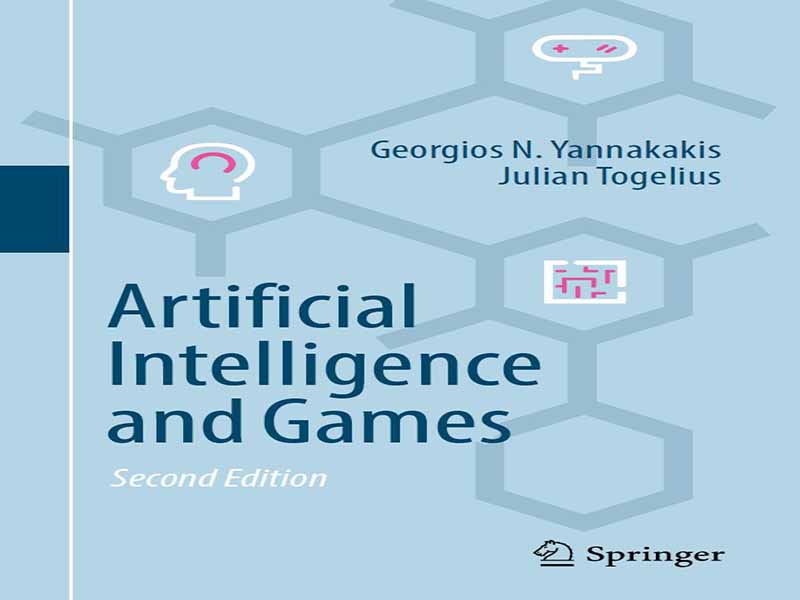- عنوان کتاب: Artificial Intelligence and Games, 2nd Edition
- نویسنده: Georgios N. Yannakakis, Julian Togelius
- حوزه: کاربرد هوش مصنوعی
- سال انتشار: 2025
- تعداد صفحه: 542
- زبان اصلی: انگلیسی
- نوع فایل: pdf
- حجم فایل: 8.90 مگابایت
باعث افتخار من است که ویرایش دوم کتاب «هوش مصنوعی و بازیها» را معرفی کنم، نشریهای که به دنبال تثبیت روشهای مختلف استقرار هوش مصنوعی (AI) در بازیها یا برای آنها است. تلاقی هوش مصنوعی و بازیها موضوعی نسبتاً پربار است. حوزه هوش مصنوعی مدتهاست که بازیها را مورد توجه قرار داده و اغلب به عنوان مکانیسمی برای برجسته کردن قابلیتهای الگوریتمهای هوشمند دیده میشود. از روزهای اولیه شطرنج و چکرز در دهههای 1950 و 1960 تا آثار معاصرتر در Go، StarCraft و Dota 2 که در رسانهها درباره آنها شنیدهاید. تمایل به ساخت سیستمهای هوشمندی که «بازی میکنند» نیز در کنار مجموعه رو به رشد ابزارها و سیستمهای هوش مصنوعی که در توسعه بازیهای تجاری به کار گرفته میشوند، قرار داشته است. به این ترتیب، وقتی کسی میگوید که به «هوش مصنوعی برای بازیها» علاقه دارد، این میتواند معانی زیادی داشته باشد. شما میتوانید در حال ساخت حریفانی برای بازیهای تختهای یا بازیهای ویدیویی استراتژیک، شخصیتهای غیربازیکن در بازیهای ویدیویی باشید که چالشی را فراهم میکنند یا از بازیکن در تجربه خود پشتیبانی میکنند. میتواند سیستمهای دشواری پویا باشد که بازیکنان را مشاهده میکنند و بازی را متناسب با آنها تغییر میدهند، یا الگوریتمهای تولید رویهای که برای ایجاد همه چیز از شخصیتها گرفته تا خطوط ماموریت، مراحل، سلاحها یا حتی کل بازیها طراحی شدهاند. اما به همان اندازه میتواند به معنای ساخت سیستمها و ابزارهایی باشد که بازیکن آنها را مشاهده نمیکند. خطوط لوله تجزیه و تحلیل دادهها برای مدلسازی و کمیسازی رفتار بازیکن در بسیاری از عناوین محبوب برای مشاهده روندهای رفتاری استفاده میشوند. از تجزیه و تحلیل نحوه برنده شدن شما در یک لحظه کلاچ گرفته تا درک اینکه آیا فهمیدهاید چگونه از یک منو یا رابط کاربری خاص استفاده کنید، یا تشخیص اینکه آیا سایر بازیکنان اطراف شما تقلب میکنند یا سمی هستند. در همین حال، چارچوبهای تضمین کیفیت که توسط هوش مصنوعی پشتیبانی میشوند، به بازیها اجازه میدهند در طول – و پس از – انتشار آزمایش شوند تا نه تنها اشکالات محصول را کاهش دهند، بلکه به توسعهدهندگان کمک کنند تا از خرابی بازی در حین ساخت آن جلوگیری کنند – یک اتفاق رایج، میتوانم به شما اطمینان دهم. اگر برای اولین بار به این فضا میپیوندید، همه اینها میتواند بسیار ترسناک باشد. چشمانداز الگوریتمها، روشها و رویکردهای هوش مصنوعی، به ویژه برای بازیها، در 20 سال گذشته به طور انفجاری گسترش یافته است. نه تنها از زمانی که تحقیقات دانشگاهی شروع به درک ارزش بازیها به عنوان مکانیسمی برای استقرار هوش مصنوعی در زمینههای علمی مختلف کردند، بلکه از زمانی که صنعت بازی شاهد گسترش این فناوریها بوده و فرصتهای موجود برای ادغام آن در خطوط تولید خود را تشخیص داده است. تلاش برای درک این موج فناوری و انتقال آن به مخاطبان گستردهتر، مدتهاست که ماموریت من بوده است، عمدتاً از طریق کارم در کانال یوتیوب هوش مصنوعی و بازیها. به مدت 10 سال، من به دنبال شرح جزئیات عملکرد دهها بازی ویدیویی تجاری و خلاصه کردن تحقیقات دانشگاهی برای مخاطبی بودهام که اغلب درک مشابهی از موضوع ندارند. در واقع، بارها از من پرسیده شده است که آیا علاقهمند به نوشتن کتابی هستم که این موضوع را برای مخاطبان علمیتر تلفیق کند. این تصوری است که من رد کردهام، زیرا نه تنها آن کتاب از قبل وجود دارد – هشدار لو رفتن داستان، شما آن را میخوانید – بلکه توسط دو نفری نوشته شده است که مسلماً بهترین تجهیزات را برای انجام این کار دارند. جورجیوس ان. یاناکاکیس و جولیان توگلیوس از زمان آغاز تحقیقات هوش مصنوعی بازی در اواسط دهه ۲۰۰۰، بر موج آن سوار بودهاند و هر دو در زمانی که جهان اهمیت کمی به آن میداد، مدرک دکترا در هوش مصنوعی برای بازیها کسب کردند. نویسندگان ما نه تنها در خط مقدم بسیاری از روشهای مورد بحث در این کتاب بودهاند – مقالات زیادی ارائه دادهاند که اغلب به دلیل تازگی یا بررسیهای جامع در مورد موضوع به آنها استناد میشود – بلکه همچنان نسل بعدی محققان و توسعهدهندگان بازی/هوش مصنوعی را در درک چگونگی قابل کنترل و عملی کردن این ایدهها راهنمایی میکنند. هم به عنوان سرپرستان فعال تحقیقات و هم به عنوان برگزارکنندگان مدرسه تابستانی هوش مصنوعی و بازیها که هر ساله از صدها شرکتکننده از سراسر جهان استقبال میکند. توگلیوس و یاناکاکیس محققانی بودند که من ۱۵ سال پیش در پایاننامه دکترای خود به آنها استناد کردم و نمیتوانم افراد زیادی را به یاد بیاورم که سهم آنها در زمینه تحقیقات هوش مصنوعی برای بازیها با سهم آنها برابری کند. بنابراین مطمئن باشید، شما در دستان امنی هستید. این ویرایش دوم، بازتابی از میزان تکامل این حوزه از زمان انتشار اولیه در سال ۲۰۱۸ است. نه تنها به این دلیل که این فناوری دستاوردهای قابل توجهی داشته است، بلکه در نحوهی بهکارگیری این فناوریها در پروژههای تجاری یا فعالیتهای علمی که از بازیها برای اهداف تحقیقاتی گستردهتر استفاده میکنند نیز صادق است. ما وارد دورهای از تغییر و تحول شدهایم، زیرا هوش مصنوعی شروع به تلاقی با گوشههای مختلف جامعه کرده است. در حال حاضر، چگونگی تأثیر روشها و ابزارهای جدید هوش مصنوعی بر توسعهی بازیهای تجاری به راحتی آشکار نیست. پیشرفت اغلب میتواند به همان سرعتی که کند است، باشد. اما دانش بنیادی مورد نیاز برای درک این فضا را میتوان در این صفحات یافت. و بنابراین، در حالی که این حوزه در سالهای آینده همچنان شاهد تغییر قابل توجهی خواهد بود، این کتاب همچنان به عنوان سنگ بنایی برای اعضای جامعهی هوش مصنوعی بازی، چه جوان و چه پیر، عمل خواهد کرد.
It’s my pleasure to introduce the second edition of the Artificial Intelligence and Games book, a publication that seeks to consolidate the variety of ways artificial intelligence (AI) can be deployed in or for games. The intersection of AI and games is a rather loaded one. The field of AI has long held games in high regard, often seen as a mechanism to highlight the capabilities of intelligent algorithms. From the early days of chess and checkers in the 1950s and 1960s through to more contemporary works in Go, StarCraft, and Dota 2 that you’ve heard about in the media. The desire to build intelligent systems that “play” has also sat alongside the growing suite of AI tools and systems deployed within commercial game development. As such, when one says they have an interest in “AI for games”, this can mean many things. You could be building opponents for board games or strategy video games, non-player characters in video games that provide a challenge or support the player in their experience. It could be dynamic difficulty systems that observe players and change the game to suit, or procedural generation algorithms designed to create everything from characters to quest lines, levels, weapons, or even entire games. But equally it can also mean building systems and tools that the player does not observe. Data analytics pipelines for modeling and quantifying player behavior are used in many popular titles to observe behavioral trends. Ranging from analyzing how you win a clutch moment, to understanding whether you figured out how to use a specific menu or interface, or detecting whether other players around you are cheating or toxic. Meanwhile, quality assurance frameworks powered by AI allow for games to be tested during—and after—release to not just reduce bugs in the product, but help developers keep the game from breaking as they’re building it—a common occurrence, I can assure you. If you’re joining this space for the first time, this can all be rather intimidating. The landscape of AI algorithms, methodologies, and approaches, specifically for games, has exploded in the past 20 years. Not only as academic research began to see the value of games as a mechanism to deploy AI in a variety of scientific contexts but also as the games industry has seen the proliferation of these technologies, and recognized the opportunities that exist to integrate it into their production pipelines. Trying to get a grasp on this technological wave and communicate it to a broader audience has long been my mission, largely via my work on the AI and Games YouTube channel. For 10 years, I have sought to detail the workings of dozens of commercial video games and summarize academic research for an audience that quite often does not have the same grasp of the subject as I do. In fact, I’ve been asked on several occasions whether I would be interested in writing a book that consolidates this for a more scholarly audience. It’s a notion I’ve rejected, because not only does that book already exist—spoiler alert, you’re reading it—but it’s written by the two people arguably best equipped to do so. Georgios N. Yannakakis and Julian Togelius have ridden the wave of game AI research since its inception in the mid-2000s, both earning Ph.D.s in AI for games at a time where the world cared little for it. Our authors have been not just at the forefront of many of the methodologies discussed in this book—delivering many papers that are often cited either for their novelty or comprehensive surveys of the subject—but continue to guide the next generation of game/AI scholars and developers in understanding how to make these ideas tractable and practical. Both as active research supervisors and as the organizers of the AI and Games Summer School which welcomes hundreds of participants each year from around the world. Togelius and Yannakakis were the researchers that I was citing in my Ph.D. thesis 15 years ago, and I can’t think of many individuals who equal their contributions to the field of AI research for games. So rest assured, you’re in safe hands. This second edition is a reflection of how much the field has evolved since the original release in 2018. Not only as the technology has seen significant gains but also in how these technologies can be applied in both commercial projects or scholarly pursuits that utilize games for broader research goals. We have entered a period of change and upheaval as AI begins to intersect various corners of society. At present how new AI methods and tooling will influence the development of commercial games is not readily apparent. Progress can often be as fast as it is slow. But the foundational knowledge required to get a grasp on this space can be found in these pages. And so while the field will continue to see a significant change in the years to come, this book will continue to serve as stepping stone for members of the game AI community both young and old.
این کتاب را میتوانید از لینک زیر بصورت رایگان دانلود کنید:




































نظرات کاربران